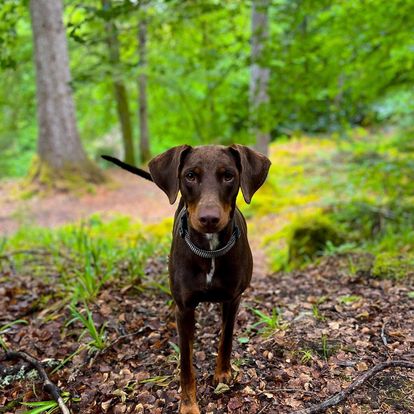Taking your dog for a walk in the countryside is a great way to bond and get some fresh air and exercise. The countryside has endless possibilities to explore and dogs with their curious noses and boundless energy love it.
But walking with dogs in the countryside is different to an urban or park walk. From wildlife to local rules, here are a few things every dog owner should know to make the walk fun and safe.

1. Know Your Route and Terrain
Before you head out on your countryside adventure, make sure you prepare by researching your walking routes. Urban dog walks are straightforward but countryside paths can be varied, with hills, moorland, forests and even farmland. Check local signs and maps for up to date information on dog friendly walks and any restrictions.

I remember once driving with my Ellie to a scenic route in the Highlands. The views were stunning—open fields and dense trees—but had I not checked beforehand I wouldn’t have known about the roaming cattle she could encounter.
Don’t Forget These Things
Tip: Always carry water, food and a first aid kit especially on longer walks. Rural areas may not have amenities and being prepared means your dog will stay hydrated and fed on the journey.
2. Leads, Recall and Wildlife
The countryside is home to cattle, lambs, horses and rare birds so dog walkers need to manage their dogs responsibly. While it can be tempting to let your dog off lead, many areas require dogs to be on lead, especially during lambing season or near farm animals.
Top Tip
Even if your dog is well trained, it’s always a good idea to have them on lead around livestock and other animals to prevent stress or injury.
When walking on moorland you should have your dog on a short lead (less than 2 meters) from 1st March to 31st July. This is the breeding season for rare birds which often lay their eggs on the ground. Disturbing these nests can have serious consequences for local wildlife so having your dog close to you means you’re doing your bit for the environment.
If you want off lead adventures, your dog needs to have good recall and be well trained to respond in distracting environments. This is an excellent blog if you are looking at leash and recall training.

3. The Countryside Code and Access Land Regulations
Follow the Countryside Code to protect wildlife, farm animals and other walkers and to ensure you and your dog have access to these areas. This means sticking to marked paths, closing gates behind you and keeping your dog under control.
It’s easy to forget that many of these routes cross private land and farmland so always look for signs that indicate access restrictions or where dogs can and can’t go.
It’s That Time Of Year
Always look out for signs that indicate restrictions such as ground nesting birds or sensitive conservation areas.
As well as general countryside etiquette there are special rules for walking your dog on access land. Between 1st March and 31st July—the main breeding period for ground nesting birds—you should have your dog on a lead no longer than 2 meters.
This simple measure means these vulnerable species can breed and raise their young without disturbance. You should do the same at any time of year near livestock. Having your dog close to you not only protects wildlife but also your dog’s safety as startled livestock can be a risk to you and your dog too.
4. Dog Owners; Clean Up!
One of the most important things during dog walks is to clean up after your dog. Dog poo ruins the experience for others and can be a health risk to wildlife, farm animals and other dogs. In rural areas where farm animals like cattle and sheep graze dog poo can cause serious illnesses like Neosporosis and Sarcocystosis both of which can harm livestock.

5. Dog Friendly Walks
Not all countryside walks are dog friendly. Look for trails that are specifically dog walks, with access to lakes, woods and forests where your dog can roam. The National Trust or North York Moors often have dog friendly walking routes with rest spots and dog safe areas.
I have found this website, ‘Walkiees’ very useful when it comes to finding top dog walking spots where I live (not sponsored!)
6. Seasonal Considerations and Other Dogs
Dog walks in the countryside can be very different depending on the season. In spring and early summer you need to be aware of ground nesting birds, lambs and new born calves. In the hotter months there are different challenges. Dogs can overheat on long walks especially on exposed routes with no shade.
If you’re walking on moorland be aware of ticks and other wildlife hazards!
You may meet other dogs while you are out so make sure you this into consideration. I have done a blog on how to socialise a nervous dog if you need any tips on this!

You made it to the FAQs!
What is the legal limit for dog walking in the UK?
Yes, in the UK you can walk a maximum of four dogs at one time unless local regulations state otherwise.
Do dogs need off-lead walks?
Is it necessary for dogs to walk off-lead? Off-lead walks are more fun but only suitable for dogs with great recall and in designated areas.
How long is a good walk for a dog?
Is there a standard distance for a good dog walk? The ideal distance varies by breed and fitness level but most dogs need a daily walk of at least 30 minutes to two hours.
Should you walk your dog daily?
Is daily exercise necessary? Yes, daily walks are vital for a dog’s physical and mental health.
What’s the best walk for dogs?
Is there an ideal walk? Countryside walks in woods, fields and by lakes are often the best for dogs.
Can I walk my dog on farmland?
Is it allowed to walk dogs on farmland? Yes, but only on public footpaths and with your dog on a lead near livestock.
Do National Trusts allow dogs?
Are dogs allowed at National Trust sites? Many National Trust properties allow dogs but there may be restrictions in certain areas. Check beforehand with the dog owner.
Where should my dog walk with me?
Is there a preferred side to walk with dogs? It’s recommended to keep your dog on your left side especially when walking on roads or narrow paths.
Conclusion
Dog walking in the countryside is a great experience for you and your dog. By following these tips from preparing with the right gear to following the Countryside Code you can enjoy your rural adventures with confidence.
Always be aware of your surroundings, look out for signs and make sure your dog is trained for on and off lead walking.
As always though, have fun!








